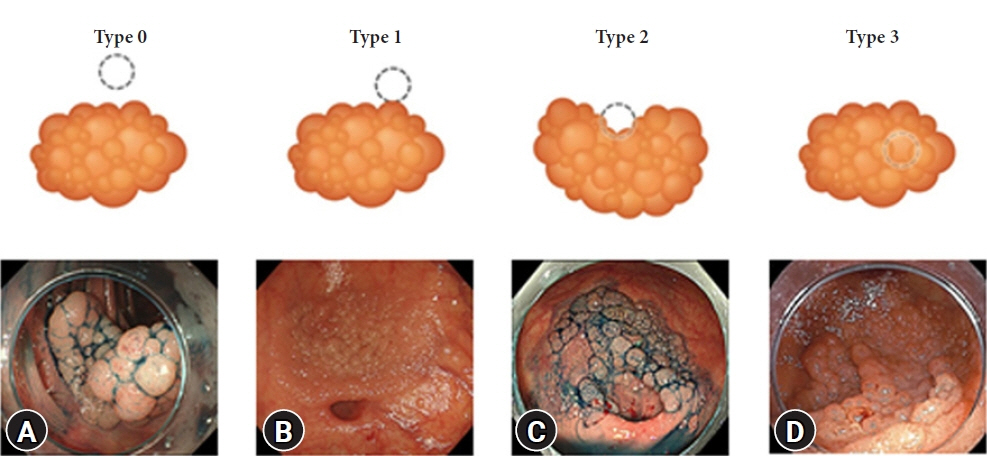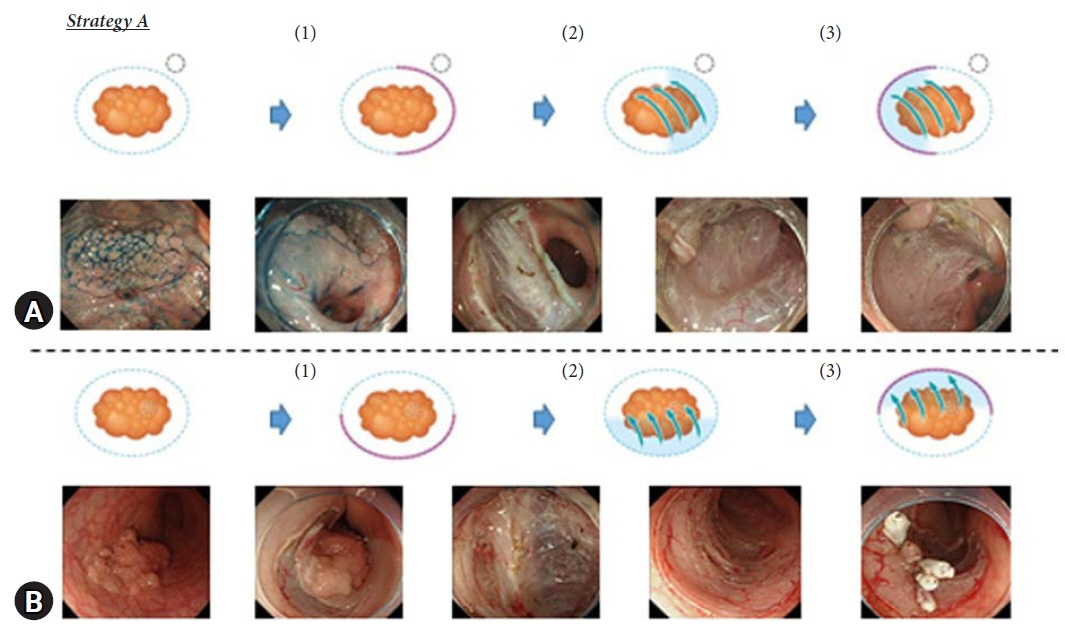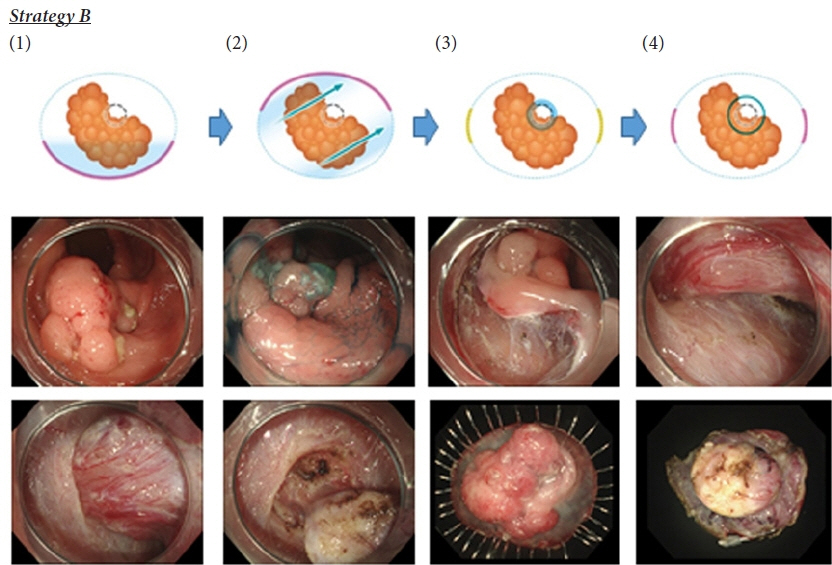Clin Endosc.
2022 May;55(3):417-425. 10.5946/ce.2021.245.
Feasibility and safety of endoscopic submucosal dissection for lesions in proximity to a colonic diverticulum
- Affiliations
-
- 1Division of Gastroenterology, Department of Internal Medicine, Graduate School of Medicine, Kobe University, Kobe, Japan
- 2Department of Endoscopy, Kobe University Hospital, Kobe, Japan
- 3Department of Gastroenterology, Kishiwada Tokushukai Hospital, Kishiwada, Japan
- 4Department of Gastroenterology, Teine Keijinkai Hospital, Sapporo, Japan
- 5Department of Gastroenterology, Yoka Municipal Hospital, Yabu, Japan
- 6Department of Gastroenterology, Port Macquarie Base Hospital, Port Macquarie, Australia
- KMID: 2529964
- DOI: http://doi.org/10.5946/ce.2021.245
Abstract
- Background/Aims
Endoscopic submucosal dissection (ESD) for diverticulum-associated colorectal lesions is generally contraindicated because of the high risk of perforation. Several studies on patients with such lesions treated with ESD have been reported recently. However, the feasibility and safety of ESD for lesions in proximity to a colonic diverticulum (D-ESD) have not been fully clarified. The aim of this study was to evaluate the feasibility and safety of D-ESD.
Methods
D-ESD was defined as ESD for lesions within approximately 3 mm of a diverticulum. Twenty-six consecutive patients who underwent D-ESD were included. Two strategic approaches were used depending on whether submucosal dissection of the diverticulum-related part was required (strategy B) or not (strategy A). Treatment outcomes and adverse events associated with each strategy were analyzed.
Results
The en bloc resection rate was 96.2%. The rates of R0 and curative resection in strategies A and B were 80.8%, 73.1%, 84.6%, and 70.6%, respectively. Two cases of intraoperative perforation and one case of delayed perforation occurred. The delayed perforation case required emergency surgery, but the other cases were managed conservatively.
Conclusions
D-ESD may be a feasible treatment option. However, it should be performed in a high-volume center by expert hands because it requires highly skilled endoscopic techniques.
Keyword
Figure
Reference
-
1. Nagata N, Niikura R, Aoki T, et al. Increase in colonic diverticulosis and diverticular hemorrhage in an aging society: lessons from a 9-year colonoscopic study of 28,192 patients in Japan. Int J Colorectal Dis. 2014; 29:379–385.2. Fu KI, Hamahata Y, Tsujinaka Y. Early colon cancer within a diverticulum treated by magnifying chromoendoscopy and laparoscopy. World J Gastroenterol. 2010; 16:1545–1547.3. Saito Y, Uraoka T, Yamaguchi Y, et al. A prospective, multicenter study of 1111 colorectal endoscopic submucosal dissections (with video). Gastrointest Endosc. 2010; 72:1217–1225.4. Repici A, Hassan C, De Paula Pessoa D, et al. Efficacy and safety of endoscopic submucosal dissection for colorectal neoplasia: a systematic review. Endoscopy. 2012; 44:137–150.5. Tanaka S, Terasaki M, Kanao H, et al. Current status and future perspectives of endoscopic submucosal dissection for colorectal tumors. Dig Endosc. 2012; 24(Suppl 1):73–79.6. Jacob H, Toyonaga T, Ohara Y, et al. Endoscopic submucosal dissection of cecal lesions in proximity to the appendiceal orifice. Endoscopy. 2016; 48:829–836.7. Yoshizaki T, Toyonaga T, Tanaka S, et al. Feasibility and safety of endoscopic submucosal dissection for lesions involving the ileocecal valve. Endoscopy. 2016; 48:639–645.8. Kobara H, Mori H, Rafiq K, et al. A peripheral approach allowing successful endoscopic submucosal dissection for early colorectal carcinoma near the diverticula. Rev Esp Enferm Dig. 2015; 107:378–379.9. Ritsuno H, Sakamoto N, Osada T, et al. Large superficial tumor of the colon involving a diverticulum removed by endoscopic submucosal dissection. Gastrointest Endosc. 2015; 82:751.10. Sakamoto T, Abe S, Nakajima T, et al. Complete removal of a colonic neoplasm extending into a diverticulum with hybrid endoscopic submucosal dissection-mucosal resection and endoscopic band ligation. Endoscopy. 2015; 47(Suppl 1 UCTN):E295–E296.11. Kato M, Uraoka T, Wada M, et al. Laterally spreading tumor involving a colon diverticulum successfully resected by endoscopic submucosal dissection. Gastrointest Endosc. 2016; 84:191–192.12. Iwatsubo T, Uedo N, Yamasaki Y, et al. Traction-assisted colorectal endoscopic submucosal dissection by use of clip and line for a neoplasm involving colonic diverticulum. VideoGIE. 2017; 2:337–338.13. Takasago T, Kuwai T, Yamaguchi T, et al. Endoscopic submucosal dissection with a scissors-type knife for post-EMR recurrence tumor involving the colon diverticulum. VideoGIE. 2017; 2:211–212.14. Yoshida N, Naito Y, Kishimoto M. Endoscopic submucosal dissection of T1 cancer with colonic diverticulum by pocket-creation method. Dig Endosc. 2017; 29:726–727.15. Jimenez-Garcia VA, Yamada M, Ikematsu H, et al. Endoscopic submucosal dissection in management of colorectal tumors near or involving a diverticulum: a retrospective case series. Endosc Int Open. 2019; 7:E664–E671.16. Tanaka S, Kashida H, Saito Y, et al. JGES guidelines for colorectal endoscopic submucosal dissection/endoscopic mucosal resection. Dig Endosc. 2015; 27:417–434.17. Yamamoto K, Hayashi S, Saiki H, et al. Endoscopic submucosal dissection for large superficial colorectal tumors using the "clip-flap method". Endoscopy. 2015; 47:262–265.18. Sakamoto H, Hayashi Y, Miura Y, et al. Pocket-creation method facilitates endoscopic submucosal dissection of colorectal laterally spreading tumors, non-granular type. Endosc Int Open. 2017; 5:E123–E129.19. Ishida T, Jacob H, Toyonaga T. The goals and pitfalls of gastric submucosal dissection: a special focus on dissection of lesions with severe fibrosis. Korean J Helicobacter Up Gastrointest Res. 2014; 14:163–173.20. Toyonaga T, Man IM, Fujita T, et al. The performance of a novel ball-tipped Flush knife for endoscopic submucosal dissection: a case-control study. Aliment Pharmacol Ther. 2010; 32:908–915.21. Takezawa T, Hayashi Y, Shinozaki S, et al. The pocket-creation method facilitates colonic endoscopic submucosal dissection (with video). Gastrointest Endosc. 2019; 89:1045–1053.22. Ritsuno H, Sakamoto N, Osada T, et al. Prospective clinical trial of traction device-assisted endoscopic submucosal dissection of large superficial colorectal tumors using the S-O clip. Surg Endosc. 2014; 28:3143–3149.23. Yamasaki Y, Takeuchi Y, Hanaoka N, et al. A novel traction method using an endoclip attached to a nylon string during colonic endoscopic submucosal dissection. Endoscopy. 2015; 47(Suppl 1 UCTN):E238–E239.24. Okamoto Y, Oka S, Tanaka S, et al. Clinical usefulness of the S-O clip during colorectal endoscopic submucosal dissection in difficult-to-access submucosal layer. Endosc Int Open. 2020; 8:E437–E444.25. Muramoto T, Ohata K, Sakai E, et al. Endoscopic submucosal dissection for colorectal neoplasms in proximity or extending to a diverticulum. Surg Endosc. 2021; 35:3479–3487.26. Valli PV, Kaufmann M, Vrugt B, et al. Endoscopic resection of a diverticulum-arisen colonic adenoma using a full-thickness resection device. Gastroenterology. 2014; 147:969–971.27. Shakhatreh MH, Hair C, Shaib YH, et al. Removal of a colonic polyp in a diverticulum: a novel use of the over-the-scope clip device. Gastrointest Endosc. 2015; 81:756.28. Isohata N, Nagata K, Utano K, et al. Recent trends in the prevalence and distribution of colonic diverticular in Japan evaluated using computed tomography colonography. World J Gastroenterol. 2021; 27:4441–4452.
- Full Text Links
- Actions
-
Cited
- CITED
-
- Close
- Share
- Similar articles
-
- Underwater Endoscopic Mucosal Resection without Submucosal Injection Facilitates En bloc Resection of Colon Adenomas Extending into a Diverticulum
- Successful Endoscopic Resection of Residual Colonic Mucosa-Associated Lymphoid Tissue Lymphoma after Polypectomy
- Endoscopic Treatment of Subepithelial Tumors
- Endoscopic Submucosal Dissection of an Inverted Early Gastric Cancer-Forming False Gastric Diverticulum
- History and Development of Accessories for Endoscopic Submucosal Dissection




